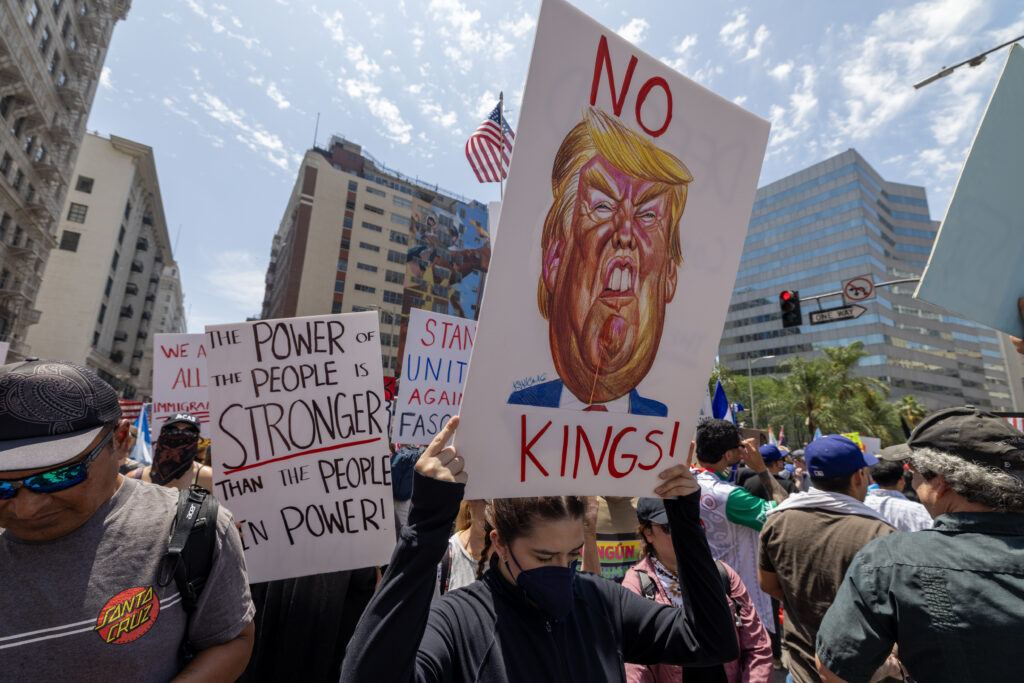Analyses / Political and Geostrategic Observatory of the United States
8 July 2025
Letter from California

While in California for the summer holidays, I recently attended two demonstrations that gave me a sense of the current pulse of the “resistance” to Donald Trump. The first, the nationwide “No Kings” movement organised on 14 June, was explicitly political and brought together millions of Americans opposed to the current administration. The second, the San Francisco Pride March—traditionally an annual celebration of the LGBTQ+ community—took on a more political tone this year, with the rallying cry: “Queer joy is resistance.” In California, it’s clear that opposition is organising and making itself heard.
For those who fear an authoritarian drift under Donald Trump, this is good news. The other safeguards of American democracy appear to be weakening—at least for now. With near-total control over the federal government and cabinet ministers fully loyal to him, the president no longer faces internal opposition as he did during his first term. Even though the Republican majority in Congress is slim and the party sometimes divided, Republican lawmakers are now fully aligned with Donald Trump. The courts have dealt him a few setbacks since his re-election, but a Supreme Court ruling handed down at the end of June (Trump v. CASA Inc.) has significantly limited the ability of lower courts to block his policies nationwide. Civil society—in particular the media and universities—has been forced to yield under repeated attacks from the administration. Even Wall Street, far from being a bastion of democracy but still a central player in a deeply capitalist country, now refuses to challenge policies that could prove harmful to the nation, instead betting on the assumption that Trump will be unable to implement them effectively.
The resistance, then, is in the streets.
This wave of protest is vital if the erosion of democratic norms is to be slowed. The early months of the Trump administration were marked by a noticeable lack of effective opposition from the Democratic Party. It was as if the violence and intensity of the new government’s actions had left the Democrats stunned and breathless, unsure where or how to respond. Even the grassroots took time to mobilise. In 2017, between three and five million Americans took part in the Women’s March, the day after Trump’s inauguration—likely the largest single-day protest in the country’s history. Eight years later, only around 50,000 demonstrators gathered for the “People’s March” to protest his return. In recent months, however, the momentum appears to be shifting. The “No Kings” movement may have far exceeded the scale of 2017. The figures remain imprecise, but organisers estimate between 5 and 11 million participants across all 50 states. I’ve discussed elsewhere the work of Erica Chenoweth, a sociologist specialising in democratic resistance to authoritarian regimes. She notes that peaceful movements which manage to mobilise at least 3.5% of the population often have the potential to counter autocratic agendas and restore democratic values. The “No Kings” movement may have reached that critical threshold.
A few reflections from the two demonstrations I attended personally… Firstly, both unfolded in a completely non-violent, even joyful atmosphere—like most democratic protests in recent times. In a context where Donald Trump is trying to portray his opposition as extremist and radical—even going so far as to deploy Marines in Los Angeles to quell supposed “unrest” caused by opponents of his immigration policy—the peaceful nature of these protests sends a clear message in response to those fabrications. A sign held by a Pride participant summed up just how harmless the demonstrators were: “You know things are bad when this many introverts are out in the streets.”
Both demonstrations managed to maintain a clear political coherence—no small feat for a movement that is far more diverse and heterogeneous than the Republican Party. “No Kings” focused squarely on the Trump administration’s attacks on the democratic process. Pride, unsurprisingly, emphasised trans rights at a time when the president is rolling back many hard-won advances for that community.
Regrettably, the demonstrators were not very young. I attended “No Kings” with friends of my mother, all in their seventies, and many participants were of the same age group. The median age of “No Kings” protestors nationwide was 36. Yet youth is an essential component of the electorate—and a demographic that tends to vote Democratic—so mobilising it is crucial.
For opponents of Donald Trump, the fight will return to the electoral arena in a few months. The midterm elections, scheduled for November 2026, could significantly alter the balance of power if the Democrats manage to win back one or both chambers of Congress. Republicans are currently debating a bill proposed by the president that would dramatically cut taxes for the wealthy while eliminating certain welfare benefits for the most vulnerable Americans. Such a policy could prove unpopular and perhaps give new momentum to the Democratic Party ahead of the vote. In the meantime, only popular mobilisation can remind voters of the importance of resisting Donald Trump.
Read regular editorials by Jeff Hawkins, former U.S. diplomat and Associate Research Fellow at IRIS, in his Notes from a State Department Veteran.

